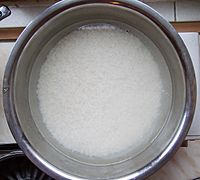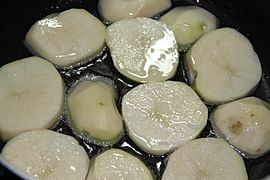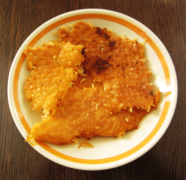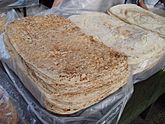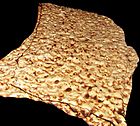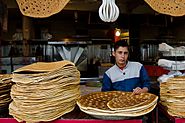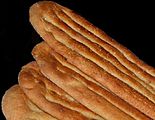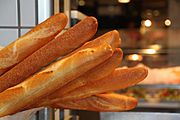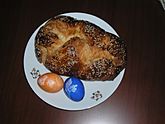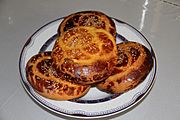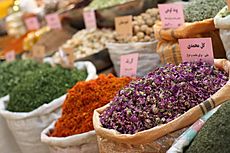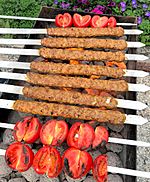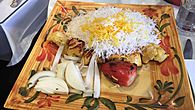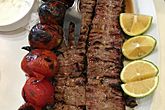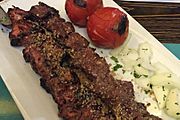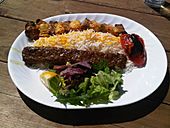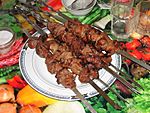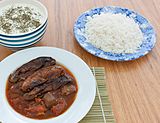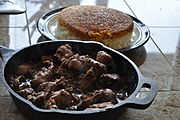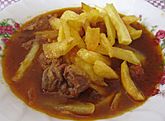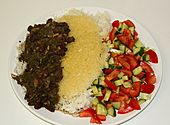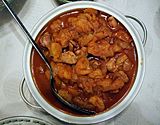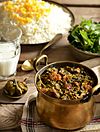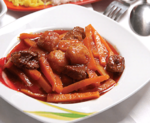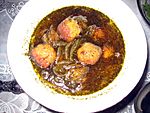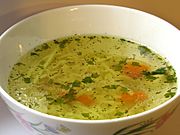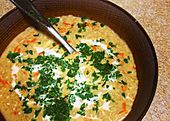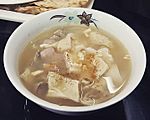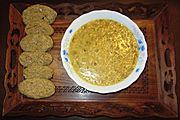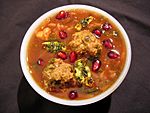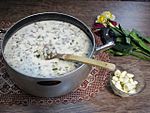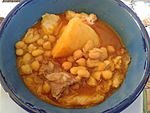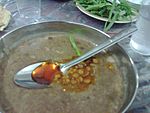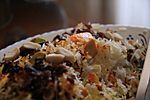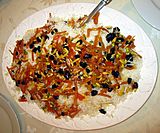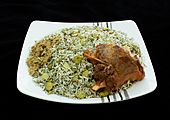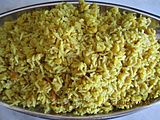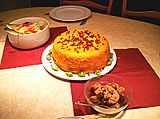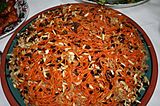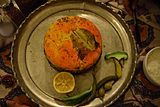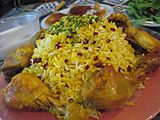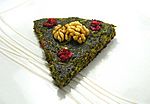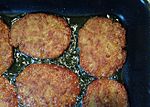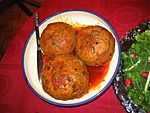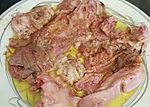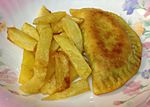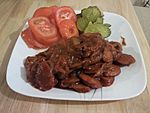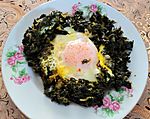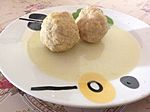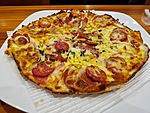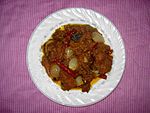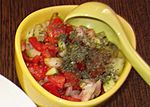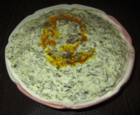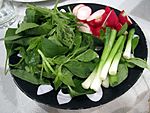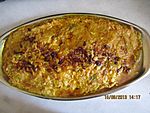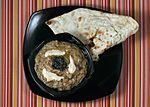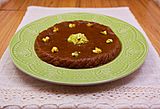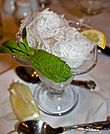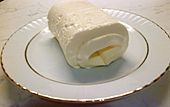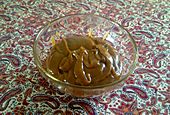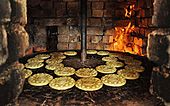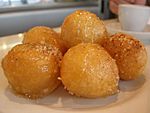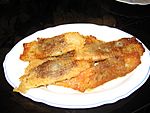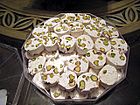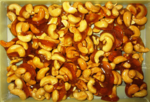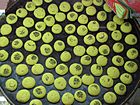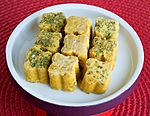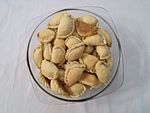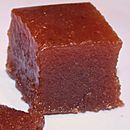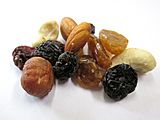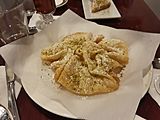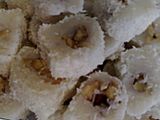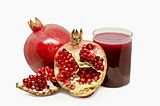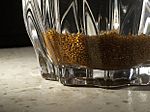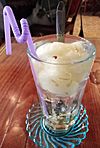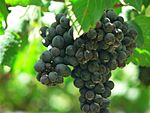Iranian cuisine facts for kids
Iranian cuisine is all about the delicious food and cooking styles from Iran. You might also hear it called Persian cuisine. This is because "Persia" was a common name for Iran in the past. Many different groups of people in Iran have helped create these amazing food traditions.
Iranian food has been influenced by its neighbors for a long time. These include countries like Greece, Turkey, and those in Central Asia. Iranian cooking also had a big impact on food in India and Pakistan a long time ago.
Typical Iranian main dishes often mix rice with meat, vegetables, and nuts. People use lots of fresh herbs and fruits like plums, pomegranates, and apricots. Special Iranian spices like saffron, cardamom, and dried lime give the food its unique taste.
You can find Iranian restaurants and food in many big cities around the world. Places like London, Toronto, and especially Los Angeles have many people from Iran, so their food is popular there too!
Contents
History of Iranian Food
Ancient writings from the Middle Persian times, like the book "Khosrow and Ridag," tell us about stews and how food was prepared during the Sassanid period. This helps us understand the history of cooking in Iran.
Many Iranian dish names and cooking words were later used in Arabic books. This happened because many Iranians worked in the courts of the Abbasid rulers. Their cooking styles naturally influenced the Arabs during the Abbasid period.
Old Iranian Cookbooks
Even though some Arabic cookbooks from the Abbasid Caliphate had Iranian recipes, the oldest Persian cookbooks we still have are from the Safavid period.
One old book, written in 1521, is called "Manual on cooking and its craft." It was made for a rich person. This book had 26 chapters, but some are now missing. It gave detailed instructions for recipes, including how much of each ingredient to use. It even told you what kind of pots to use and how to decorate the dishes! The ingredients and mixes in these old recipes are quite similar to what people use today. The recipes often used large amounts of expensive ingredients like saffron. This suggests the dishes were for big, wealthy families.
Another Safavid cookbook, from about 76 years later, was written by a chef for Shah Abbas I. This book talks about how to prepare different dishes. It has four chapters on rice dishes, one on stews, and one on thick soups. The instructions are not as detailed as the older book. It mostly shares recipes from the royal court. It even mentions some dishes that the shahs themselves created or improved!
Main Foods in Iran
Rice Dishes
Using rice became very popular in Iranian cooking by the end of the 1500s. At first, it was a special food for the Safavid court. Traditionally, rice was a main food in northern Iran and for rich families. In other parts of the country, bread was more common.
Some types of rice grown in Iran include gerde, domsia, champa, doodi (smoked rice), Lenjan, Tarom, and anbarbu.
Here are three main ways Iranians cook rice:
| Method | Description |
|---|---|
| Polow and chelow | Chelow is plain rice served with a stew or kebab. Polow is rice mixed with other ingredients. Both are cooked similarly. Rice is soaked in salted water, then boiled. The partly cooked rice is drained and steamed in the pot. This makes the rice fluffy and separate. A golden crust called tadig forms at the bottom. This crust is often made with bread or potato slices. Sometimes, meat, vegetables, nuts, or fruit are added in layers with the rice before steaming. A thick cloth is placed under the pot lid to soak up extra steam. |
| Kateh | This rice is cooked until all the water is soaked up. It's a traditional dish from Gilan Province. |
| Dami | Dami is cooked much like kateh. But at the start, ingredients like grains and beans are added with the rice. The heat is kept low until everything is cooked. Like kateh, dami can also make a tadig if cooked long enough. A special dami dish is tachin. It's a mix of yogurt, chicken (or lamb), rice, saffron, and egg yolks. |
Bread Varieties
After rice, wheat is the next most important food in Iran. Here are some common flatbreads and pastry breads used in Iranian cooking:
| Lavash: This bread is thin, flaky, and either round or oval. It's the most common bread in Iran and the Caucasus region. | Sangak: A plain, rectangular, or triangle-shaped flatbread. It's special because it's baked on hot stones. | Taftun: This flatbread is thin, soft, and round. It's a bit thicker than lavash. | Qandi bread: A sweet bread. It can be soft like brioche or flat and dry. | Barbari: A thick, oval flatbread. It's also known as Tabrizi, named after the city of Tabriz. |
| Baguette: This is a long, narrow French loaf. It's often filled with sausages and vegetables in Iran. | Sheermal ("milk-rubbed"): A sweet pastry bread. It's also widely known as nan-e gisou. | Komaj: A sweet date bread. It has turmeric and cumin and is similar to nan e gisu. |
Fruits and Vegetables
Iran's farms grow many different fruits and vegetables. So, you'll often see a bowl of fresh fruit on Iranian tables. Vegetables are also common side dishes with most meals. People enjoy them fresh and ripe as desserts. They also mix them with meat in main dishes.
When fresh fruits aren't available, many dried fruits are served. These include dates, figs, apricots, plums, and peaches. Southern Iran is a big producer of dates. Some special types, like the Bam date, are grown there.
Common vegetables in Iranian dishes include pumpkins, spinach, green beans, fava beans, courgette, different types of squash, onion, garlic, and carrot. Tomatoes, cucumbers, and scallions often come with a meal. The eggplant is very popular, sometimes called "the potato of Iran." Iranians also love fresh green salads. These are dressed with olive oil, lemon juice, salt, chili, and garlic.
Fruit dolma is a special Iranian dish. The fruit is cooked first, then stuffed with meat, seasonings, and sometimes tomato sauce. The dolma then simmers in meat broth or a sweet-and-sour sauce.
Verjuice is a very sour juice made from unripe grapes or other sour fruits. It's used in many Iranian dishes. It's mainly added to soups and stews. Unripe grapes are also used whole in some dishes, like khoresh e qure (lamb stew with sour grapes). Sometimes, verjuice is dried and used as a powder spice.
Common Spices
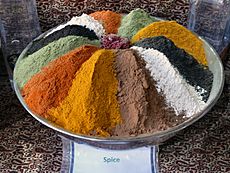
Advieh or chāshni is a name for many strong-flavored vegetables and dried fruits. These are used in Iranian cooking to add taste to food.
One of the most traditional and popular Iranian spices is saffron. It comes from the flower of the Crocus sativus. Rose water, which is water flavored by soaking rose petals, is also a common ingredient in many Iranian dishes.
Persian hogweed (golpar) grows wild in the rainy mountains of Iran. It's used as a spice in different Iranian soups and stews. It's also mixed with vinegar for dipping broad beans.
Other common spices include cardamom, shevid (an herb like celery), mahleb (from cherry seeds), and limu amani (dried lime).
There are also special spice mixes. Two examples are arde, made from toasted sesame seeds, and delal sauce, made from very salty fresh herbs like cilantro and parsley.
Popular Iranian Foods and Drinks
Main Course Dishes
Kebab Dishes
In Iran, kebabs are served with either rice or bread. A dish of white rice with kebab is called chelow kabab. It's considered the national dish of Iran! If the rice is made using the kateh method, the dish is called kateh kabab.
Here are some types of kebab in Iranian cooking:
| Kabab koobideh: This is barbecued ground lamb or beef. It's mixed with parsley and onion. | Juje kabab: Grilled pieces of chicken. It's one of the most common dishes in Iran. | Kabab barg: Barbecued and marinated lamb, chicken, or beef. |
| Kabab torsh: A traditional kebab from Gilan and Mazenderan. It's marinated in a paste of crushed walnuts, pomegranate juice, and olive oil. | Kabab Bakhtyari: A mix of barbecued lamb (or veal) fillet and chicken breast. | Chenje: Skewered and grilled cubes of meat. It's like the Iranian version of shish kebab. |
| Shashlik: Another popular type of shish kebab. In Iranian cooking, shashlik usually means large chunks of meat. | Kabab tabei: Homemade grilled meat, cooked in a pan. | Bonab kabab: A type of kebab made from ground mutton, onion, and salt. It comes from the city of Bonab. |
Stew Dishes
Khoresh is an Iranian type of stew. It's usually served with a plate of white rice. A khoresh typically has herbs, fruits, and pieces of meat. It's flavored with tomato paste, saffron, and pomegranate juice. Other stews, like dizi, are eaten with bread instead of rice.
Here are some Iranian stew dishes:
| Khoresh e bademjan: Eggplant stew with tomato, verjuice, and saffron. | Khoresh e fesenjan: A stew flavored with pomegranate syrup and ground walnuts. | Khoresh e qeyme: A stew with split peas, French fries, and dried lime. | Qorme sabzi: A stew with herbs like parsley, leek, cilantro, and fenugreek. |
| Khoresh e karafs: Stewed celery and meat. | Khoresh e alu: Stewed prunes and meat. | Khoresh e alu-esfenaj: Stewed prunes, spinach, and meat. | Khoresh e havij: Stewed carrots and meat. |
| Khoresh e qarch: Mushroom stew. | Baqala qatoq: A stew from Gilan with fava beans, dill, and eggs. | Dizi (piti): Mutton stew with chickpeas and potatoes. | Kufte rize: A meatball stew from Azerbaijan and Kurdish areas. |
Soups and Āsh
Iranian cooking has many kinds of soup. These include sup e jow (barley soup), sup e esfenaj (spinach soup), and sup e qarch (mushroom soup). A thick soup is called āsh in Iran. shole qalamkar is a "hodge-podge" soup made from many different ingredients.
Here are some soup and āsh dishes in Iranian cooking:
| Sup e morgh: Chicken and noodle soup. | Sup e jow: Barley soup. | Sirabi: Tripe soup, also known as sirab shirdun. |
| Tarkhine: Grain and yogurt soup. | Gazane: Nettle soup. | Adasi: Lentil soup. |
| Āsh e reshte: A thick noodle soup. | Āsh e anār: A thick pomegranate soup. | Āsh e doogh: A thick buttermilk soup. |
| Kalle Joosh: A thick Kashk soup. | Bozbash: Meat soup with red or white beans, green vegetables, herbs, onions, leeks, dried limes, and spices. | Shole: A thick soup with meat, different beans, bulgur, rice, nutmeg, and other spices. Shole is originally from Mashhad. |
Polow and Dami Dishes
Besides rice with kebab or stew, there are many Iranian rice dishes cooked using the polow and dami methods.
Polow is the Persian word for pilaf. A polow dish has rice mixed with vegetables, fruits, and beans. It's usually served with chicken or red meat. Dami dishes are similar to polow because they mix ingredients with rice. However, dami dishes are cooked all in one pot.
Here are some traditional Iranian rice dishes:
| Sabzi polow: Rice with chopped herbs. It's usually served with fish. | Lubia polow: Rice with green beans and minced meat. | Albalu polow: Rice with sour cherries and slices of chicken or red meat. | Morasa polow: Rice "jeweled" with barberries, pistachios, raisins, carrots, orange peel, and almonds. |
| Shirin polow: Rice with sweet carrots, raisins, and almonds. | Adas polow: Rice with lentils, raisins, and dates. | Baqali polow: Rice with fava beans and dill weed. | Dampokhtak: Turmeric rice with lima beans. |
| Tachin: A Rice cake that includes yogurt, egg, and chicken fillets. | Quabili polow: Rice with raisins, carrots, and beef or lamb. | Kalam Polow: Rice with cabbage and different herbs. | Zereshk Polow: Rice with berberis and saffron. |
Other Main Dishes
| Kuku: Whipped eggs mixed with herbs or potato. | Kotlet: A fried mix of ground beef, mashed potato, and onion. | Olivier salad: A mix of potato, eggs, peas, and diced chicken (or sausage), with mayonnaise. | Caviar: Salt-cured fish eggs. |
|
|
Kufte: Meatball or meatloaf dishes. | Zaban: Beef tongue. | Pache: Boiled parts of cow or sheep, also known as khash. |
| Pirashki: Baked or fried buns filled with different ingredients. | Sosis bandari: A traditional sausage with onion, tomato paste, and chili pepper. | Nargesi: A type of spinach omelette. | Sirabij: A type of garlic omelette. |
| Gondi: An Iranian Jewish dish made of meatballs. | Iranian pizza: A typical Iranian pizza. | Dopiaza: A traditional Shiraz curry made with lots of onions. | Joshpara: Azerbaijani meat-filled dumplings. |
| Shenitsel: Fried breaded meat. | Tomato scrambled eggs: A dish made from eggs and tomato. | Jaqur-Baqur: A dish made from sheep's heart, liver, and kidney. | Biryan: A traditional dish from Isfahan. It's made from minced meat, fat, onion, cinnamon, saffron, walnut, and mint. It's served with baked lung. |
Appetizers
| Torshi: A mixed pickles salad. | Salad Shirazi: Chopped cucumbers, tomato, and onion with verjuice and a little lemon juice. | Borani: Yogurt mixed with spinach and other ingredients. | Mast o khiar: Strained yogurt with cucumber, garlic, and mint. |
| Sabzi (greens): Fresh herbs and raw vegetables. | Zeytun parvarde: Olives in a paste made of pomegranate, walnut, and garlic. | Mirza Qasemi: Grilled eggplant with egg, garlic, and tomato. | Kashk e bademjan: A mix of kashk (a dairy product), eggplant, and mint. |
Desserts
Around 400 BC, ancient Iranians created a special chilled food. It was made with rose water and vermicelli noodles. This was served to royalty in the summer. Ice was mixed with saffron, fruits, and other flavors.
Today, one of the most famous Iranian desserts is faloodeh. It's a semi-frozen noodle dessert that comes from the city of Shiraz. Bastani e zaferani, which means "saffron ice cream" in Persian, is a traditional Iranian ice cream. It's also called "the traditional ice cream." Other common Iranian desserts include different kinds of rice, wheat, and dairy sweets.
Here are some Iranian desserts:
| Fereni: Sweet rice pudding flavored with rose water. | Sholezard: A saffron rice-based dessert. | Halva: Made from wheat flour and butter, flavored with rose water. | Bastani e zaferani: Saffron ice cream. |
| Faloodeh: Vermicelli noodles mixed in a semi-frozen syrup of sugar and rose water. | Sarshir: A creamy dairy product similar to clotted cream. | Samanu: A sweet paste made from germinated wheat. It's typically served for Nowruz (Persian New Year). |
Snacks
Cookies seem to have started in Iran in the 600s, soon after sugar became common. Modern Iran has many traditional and adopted snacks. Here are some of them:
| Koluche: Cookies, mainly made in Fuman and Lahijan. | Bamie: Deep-fried dough soaked in sugar syrup. | Baqlava: A pastry made of thin dough (filo), nuts, and sugar syrup. | Reshte khoshkar: Fried and spiced rice flour and walnut. |
| Nougat and gaz: Made of sugar, nuts, and egg white. | Sohan: A saffron brittle candy with nuts. | Sohan asali: Brittle candy with honey. | Nan-e berenji: Rice flour cookies. |
| Tabrizi Lovuez: Diamond-shaped sweets made of almond powder, sugar, and saffron. | Nokhodchi: Chickpea cookies. | Qottab: An Almond-filled deep-fried pastry. | Kolompe: A Pie made of dates and cardamom. |
| Nabat chubi: Rock candy, often flavored with saffron in Iran. | Pashmak: Cotton candy. | Trail mix: Dried fruit, grains, and nuts. | Quince cheese: Made of quince and sugar. |
| Ajil e Moshkel-gosha: A traditional packed trail mix for Nowruz. | Gush e fil: Dough topped with pistachios and powdered sugar. | Poolaki: Thin candy made of sugar, water, and white vinegar. | Baslogh: Pastry made of grape syrup, starch, and almond. |
Drinks
Iran is a big producer of tea, especially in its northern areas. In Iranian culture, tea (čāy) is very popular. It's usually the first thing offered to a guest. Iranians often put a piece of sugar cube in their mouth before drinking tea. Rock candies, often flavored with saffron, are also widely used.

Traditional Iranian coffee (qahve, or kāfe) is strong and sweet. In the 1500s, coffee was first used for health reasons in Safavid Iran. Traditional coffeehouses were popular places where people drank coffee, smoked tobacco, and read poetry. Today, cafes are popular in cities. They serve many kinds of coffee and desserts. Turkish coffee is also popular in Iran, especially among Iranian Azeris.
Wine (mey) has a long history in Iranian culture. Shirazi wine was Iran's most famous wine. It came from the city of Shiraz. By the 800s, Shiraz was known for making the best wine in the world. After the 1979 Revolution, alcoholic drinks became prohibited in Iran. However, non-Muslim groups like Christians, Jews, and Zoroastrians are allowed to make alcoholic drinks for their own use. Non-alcoholic beer (ābjow) is available legally.
Araq sagi is a strong alcoholic drink made in Iran. It's usually made at home from raisins. Before the 1979 Revolution, it was made in many Iranian cities. Since it became illegal, it's now made and sold secretly.
Here are some Iranian cold drinks:
| Doogh: A cold yogurt drink. | Pomegranate juice | Carrot juice, sometimes mixed with ice cream. | Khakshir: A cold sweet drink with Descurainia sophia seeds. |
| Sekanjebin: A cold drink made of honey and vinegar. | Aragh sagi: A type of distilled alcoholic beverage. | Sharbat: A cold and sweet drink made from fruits or flower petals. | Shiraz wine: Wine made from Shiraz grapes around the city of Shiraz in Iran. |
Regional Iranian Food Styles
Azerbaijani Cuisine
The Azerbaijani people live mainly in the Azerbaijan region of northwestern Iran. They have many local dishes. These include Bonab kabab, the dumpling dish of joshpara, and a dish like the Scottish haggis called jaqur-baqur. They also have a type of āsh called kələcoş and a version of qeyme called pıçaq. A type of kufte is called Tabriz meatballs. There's also the traditional pastry of shekerbura, which is similar to Khorasan's shekarpare. Even with influences from Turkey, the food tastes very Iranian. It also has its own special touches, like using more lemon juice and butter.
Balochi Cuisine
Meat and dates are the main ingredients in the food of Iran's southeastern region of Baluchistan. Rice is mostly grown in the Makran area. Foods specific to Iranian Baluchistan include tanurche, which is grilled meat cooked in a tandoor oven. There's also doogh-pa, a type of khoresh that has doogh (yogurt drink). Tabahag is meat prepared with pomegranate powder. Baluchi food also includes many date-based dishes and different kinds of bread.
Caspian Cuisine
The southern coast of the Caspian Sea includes the Iranian provinces of Gilan, Mazenderan, Alborz, and Golestan. This area has rich land, which shows in its food. Kateh is a way of cooking rice that started here. This rice dish is also eaten for breakfast, either warm with milk and jam, or cold with cheese and garlic. Caviar fish eggs also come from this region. They are usually served with eggs in frittatas and omelettes. Local cookies (koluče) from this region are also popular.
Kurdish Cuisine
The region of Kurdistan in western Iran has many local āsh, pilaf, and stew dishes. Some local Kurdish foods include a traditional grilled rib meat called dande kabāb. There's also a type of khoresh made of chives called xoreš-e tare, and a dish of rice and potatoes called sib polow.
Southern Iranian Cuisine
The food in southern Iran is usually spicy. Mahyawa is a tangy sauce made from fermented fish in this region. Since it's a coastal area, Khuzestan's food includes a lot of seafood. It also has some unique local drinks. In southern Khuzestan, there's also a type of kufte called kibbeh. It's made from ground meat, cracked wheat, different herbs, vegetables, and spices.
Turkmen Cuisine
Iran's Turkmen people mostly live in the Iranian provinces of Golestan and North Khorasan. Chegderme is a Turkmen dish made of rice, meat, and tomato paste.
Meal Times and Table Manners
Meals in Iran
Breakfast
A basic traditional Iranian breakfast includes different flat breads, butter cubes, white cheese, and whipped heavy cream (sarshir). The cream is often sweetened with honey. Nuts, especially walnuts, and various fruit jams are also common.
Many cities and towns in Iran have their own special breakfast dishes. Pache is a popular traditional dish eaten in Iran and nearby countries. It's almost always served only from early morning until after sunrise. Special restaurants that only serve pache are open only during these hours.
Lunch and Dinner
Traditional Iranian cooking takes time, sometimes hours of preparation. The result is a balanced mix of herbs, meat, beans, dairy products, and vegetables. Main foods eaten with almost every meal include rice, various herbs, cheese, different flat breads, and some type of meat. This is usually poultry, beef, lamb, or fish. Stew over rice is the most popular dish. The types of stews change depending on the region.
Traditional Table Setting
First, a tablecloth called sofre is spread out. This can be on a table or a rug. The main dishes are placed in the middle. Smaller dishes with appetizers, sauces, and side dishes are put around them, closer to the people eating. Once all the food is perfectly arranged, everyone is invited to sit at the sofre and start their meal. |
See also
 In Spanish: Gastronomía de Irán para niños
In Spanish: Gastronomía de Irán para niños



